美国人眼里的多渠道仓库自动化工具组合思路
1.卸货,无动力输送线对接到车厢中 2.处理后,它们被输送到存储区或AutoStore的补货缓冲区。
2.处理后,它们被输送到存储区或AutoStore的补货缓冲区。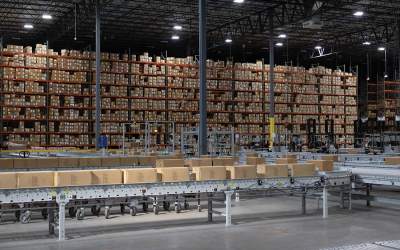 3.纸箱放在上层的存储区中。
3.纸箱放在上层的存储区中。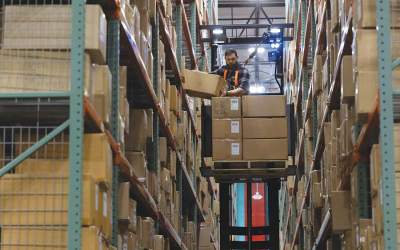 4.项目被导入到AutoStore的容器中。
4.项目被导入到AutoStore的容器中。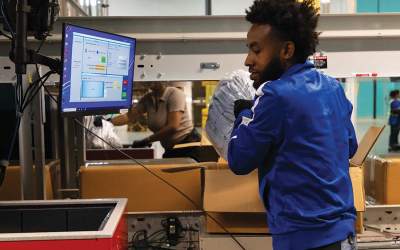 5.机器人上架与下架。
5.机器人上架与下架。 6.在工作站,作业人员从周转箱里挑选货物,放入运输纸箱。
6.在工作站,作业人员从周转箱里挑选货物,放入运输纸箱。 7.使用机械臂拾取单个物品。
7.使用机械臂拾取单个物品。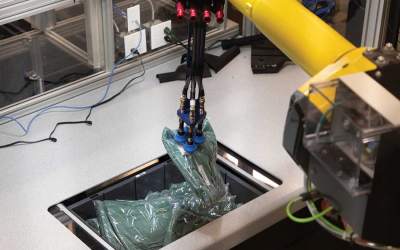 8.全场输送分拣系统。
8.全场输送分拣系统。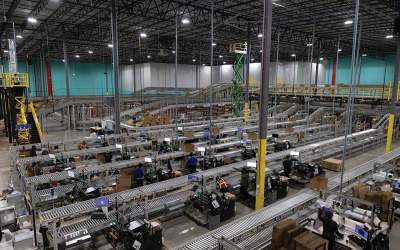 9.同时,螺旋输送机将夹层与楼层活动连接起来进行垂直转运
9.同时,螺旋输送机将夹层与楼层活动连接起来进行垂直转运

未来的电子商务配送中心会是什么样子?自动化工具包中的哪些工具可以组合在一起,以最大限度地减少产品在建筑中流动时的人工干预或转换(minimize touches),同时最大限度地利用这些作业环节中的人员灵活性?
仓库运营商在设计新系统和将新解决方案引入市场时,每天都在问这些问题。一个潜在的答案是在俄亥俄州哥伦布市附近建立一个40万平方英尺的电子履行设施,由全球第三方物流(3PL)提供商乔达运营,乔达一直是采用新自动化技术的领导者。《现代》杂志在2019年2月号上首次发表了一篇关于乔达采用自主移动机器人的文章。
专业零售商Maurices的新设施(由乔达内部团队和巴斯蒂安解决方案公司设计)是一座全渠道建筑,可满足直接面向消费者的订单;门店补货;以及以最少的
人工干预或转换(minimize touches) 从单个库存中在线购买/运送到商店。在零售履行业务中,从订单下降到订单出库,大多数库存只
人工干预或转换(minimize touches) 一次。
从收货码头到发货码头,对于电子商务订单或去商店的混合SKU订单,从收货到发货,库存大约被搬动了八次;对于从储备储存区中取回的完整箱子进行五次储存以补充储存器;两次用于从收货到发货的交叉对接箱子。
乔达负责美洲地区设计工程的副总裁Drew Bailey指出,灵活性是设计的一个关键因素。Bailey说:“我们试图解决的一件事就是我所说的频道不可知设施。”。“如果未来的增长计划与预测不同,Maurices希望有一个足够灵活的解决方案来适应这些变化。我们投入的一切——机器人、订单分拣口、搬运箱和网格——都可以在未来进行扩展,而无需重大建设项目。”
该功能的核心是AutoStore的最新迭代。有人称之为“黑色机器人”,它比人们更熟悉的红色机器人更高效,它们几乎是所有SKU的实现引擎,除了那些体积太大或太脆弱而无法通过自动化处理的SKU,如香水或大衣等超大物品。该设施启用了320个机器人,并计划扩大到400个。
该系统有34个AutoStore RelayPorts用于分拣。其中,29个目前被配置用于从供体手提箱中挑选到运输托盘的同事;五个配置用于工件拾取机器人。Bailey说:“我们从五个机器人端口开始,但未来所有端口都可以转换为机器人。”。
包装也是自动化的。零售订单自动调整大小并密封交付,而电子商务订单则通过自动装袋机进行单件和多件订单。与分拣一样,他们有一个小的手动区域,用于存放无法通过自动化处理的物品。
最后,纸箱在收到后会自动标注尺寸,在某些情况下还会自动贴上标签以备运输。Bailey说:“我们努力成为早期采用者,并在有意义的地方突破极限,确保新的关系。”。“归根结底,技术帮助我们做到了这一点。”
冒自动化风险
乔达总部位于巴黎,是世界上最大的第三方物流公司之一,2022年其全球业务收入近150亿美元。该公司为82000名客户提供服务,在覆盖近170个国家和约8000万平方英尺仓库空间的全球网络中拥有49400多名员工。仅通过分销和快递业务,该公司每年就运送超过1亿个包裹。在美国,乔达经营着230多个仓库,仓库面积超过5000万平方英尺。它服务于各种垂直领域,包括零售和电子商务履行、高科技、快速消费品、医疗保健、工业和汽车。
与其他第三方物流供应商一样,乔达正在采用技术将其业务带入未来。Bailey说:“我们为自己冒着健康的风险变得比今天更好而感到自豪。”。“这是我们内部正在进行的对话,我们试图找到创新的机器人公司与我们一起踏上这段旅程。”
至于客户,他补充道,在乔达为Maurices运营的单租户建筑中,第三方物流必须将其风险承受能力与客户的保持一致。“这是一种平衡,我们必须在这一点上保持一致。”
与其他第三方物流供应商一样,乔达的自动化是由任何运营配送中心的人都熟悉的趋势驱动的。Bailey说,一个是电子商务订单的增加,但也需要“适应强加给我们客户的市场”。“在点击即发货中,每个人都试图与亚马逊设定的交货时间表竞争。”另一个是劳动力短缺的组合
1. Cartons are received
2. After processing, they are conveyed to the reserve storage area or to induction for AutoStore.
3. Cartons are putaway in the upper levels in reserve storage.
4. Items are inducted into containers for the AutoStore.
5. Bots putaway and retrieve totes.
6. At workstations, associates pick from totes into shipping cartons.
7. Single items are picked using robotic arms.
8. The conveyor system moves cartons throughout the facility.
9. Meanwhile the spiral conveyor connects the mezzanine with floor-level activities
The 3PL’s new facility in Asheville, Ohio, is a showcase for next-generation technologies, including robotics and automated packaging.
What will the e-commerce distribution center of the future look like? And which of the tools in the automation toolkit might come together to minimize touches as product flows through a building, all while making the best and most productive use of the human component of those operations?
Warehouse operators are asking those questions every day as they design new systems and as new solutions are introduced into the market. One potential answer is a 400,000-square-foot, e-fulfillment facility near Columbus, Ohio, operated by GEODIS, a global third-party logistics (3PL) provider that has been a leader in the adoption of new automation technologies. Modern first published an article about GEODIS’s adoption of autonomous mobile robots (AMRs) in the February 2019 issue.
The new facility for specialty retailer Maurices (designed by GEODIS’s internal team and Bastian Solutions), is an omnichannel building that fulfills direct-to-consumer orders; store replenishment; and buy online/ship-to-store from a single inventory with minimum touches. In retail fulfillment operations, most inventory is touched only once from the time an order drops until it goes out the door.
Looked at from dock to dock, inventory is touched approximately eight times from receiving to shipping for e-commerce orders or mixed-SKU orders going to a store; five times for a full case that is retrieved from reserve storage for store replenishment; and twice for crossdocked cases from receiving to shipping.
Flexibility was a key element of the design, notes Drew Bailey, GEODIS’s vice president of design engineering for the Americas region. “One of the things we were trying to solve for was what I’ll call a channel-agnostic facility,” Bailey says. “In the event that future growth plans change from the forecast, Maurices wanted a solution that was flexible enough to adapt to those changes. Everything we put in—the robots, order picking ports, totes and grid—can be expanded in the future without a major construction project.”
At the heart of the facility is the latest iteration of AutoStore. Some call this “the black bots,” which are more efficient than the more familiar red bots, and they serve as the fulfillment engine for almost all SKUs except those that are too bulky or fragile to be handled by automation, such as perfume or oversized items like coats. The facility went live with 320 bots, with plans to expand to 400.
The system has 34 AutoStore RelayPorts for picking. Of those, 29 are currently configured for associates who pick from the donor totes to shipping trays; five are configured for piece-picking robots. “We’re starting with five robotic ports, but all could be converted to robots in the future,” Bailey says.
Packing is also automated. Retail orders are automatically right sized and sealed for delivery, while e-commerce orders go through autobaggers for single- and multi-item orders. As with picking, they have a small manual area for items that can’t be handled by automation.
Finally, cartons are automatically dimensioned upon receipt and in some cases automatically labeled for shipping. “We try to be early adopters and push the envelope where it makes sense to secure new relationships,” Bailey says. “Ultimately, technology helps us do that.”
Taking a risk on automation
With headquarters in Paris, GEODIS is one of the largest 3PLs in the world, generating nearly $15 billion USD in revenue across its global operations in 2022. The company services 82,000 customers, with more than 49,400 employees across a global network that reaches nearly 170 countries and approximately 80 million square feet of warehouse space. It moves more than 100 million parcels a year through its Distribution and Express business alone. In the United States, GEODIS operates more than 230 sites, representing over 50 million square feet of warehousing space. It serves a variety of verticals, including retail and e-commerce fulfillment, high tech, fast-moving consumer goods, health care, industrial and automotive.
And, as with other 3PL providers, GEODIS is adopting technology to take its operations into the future. “We pride ourselves on taking a healthy amount of risk to be better than we are today,” says Bailey. “That’s the conversation we’re having internally, and we try to find innovative robotics companies to go on this journey with us.”
As to customers, he adds, in a single tenant building like the one GEODIS is operating for Maurices, the 3PL has to align its tolerance for risk with the customer’s. “It’s a balance, and one that we have to be well aligned on.”
As with other 3PL providers, automation at GEODIS is driven by trends familiar to anyone operating a distribution center. One is the rise in e-commerce orders, but also the need “to adapt to the market that’s imposed on our clients,” Bailey says. “In click-to-ship, everyone is trying to compete with a delivery timeline that’s been set by Amazon.” The other is the combination of labor shortages

全部 0条评论